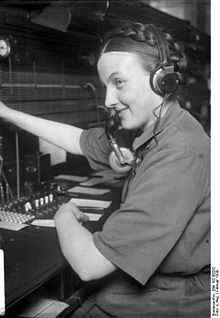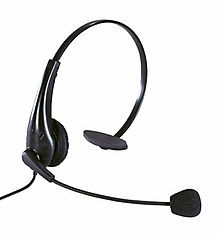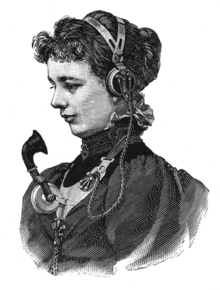Headset (audio)
![]()
This article deals with the headset as a two-way communication device. For the use of headsets without loudspeakers in performances or television productions (neckband microphone), see radio microphones.
![]()
This article or section needs revision. More details should be given on the discussion page. Please help improve it, and then remove this tag.
A headset is a combination of headphones and microphone that enables two-way communication (listening and speaking). The English term headset has also become established in the German-speaking world.
With its technical components, a headset performs the same tasks as a telephone handset. The advantage lies in the freedom of both arms. Headsets are therefore becoming increasingly popular, especially when working on computers, laptops, PDAs or in conjunction with a mobile phone. The low price is certainly also beneficial.
There is often a volume control in the connection cable. In professional solutions (e.g. for call centres), the microphone can be muted at the touch of a button.
Headsets typically use an electret microphone that requires power to operate, which is supplied to it via a remote power supply, such as a computer's jack.

A telephone operator at work (1930)

Headset

"Chest microphone and headphone" in the Ericsson catalogue from 1897
Designs
Headphones with two earcups (binaural) and microphone on the earpiece
Stereo reproduction is possible due to the two speakers. The perception of the environment is limited, which can be evaluated positively or negatively depending on the application and situation. This is a common design for use on the computer, in amateur and aviation radio. Especially for computer use, lightweight versions with neckband are also offered.
Headphones with only one earcup (monaural) and microphone at the earpiece
Since there is only one speaker, only mono playback is possible. The perception of the surroundings is less restricted. This design enjoys great popularity in telephony and corresponds most closely to a telephone receiver.
In-ear headphones with microphone attached to the cable
The smallest and lightest version is often used in mobile phones. In versions with two earphones, stereo playback is also possible. Due to the inconspicuousness, outsiders may think that the user is talking to himself.
Wireless headsets
A radio connection, based on the Bluetooth or DECT method, means that a cable can be dispensed with. This design is also often used with mobile phones. The headset is somewhat heavier than wired earphones due to the built-in technology. Essential purchase criteria are usually the voice quality and, depending on the built-in accumulator, the standby and talk time.
Connection
Telephones
A frequent application for headsets is the use on workstation telephones. Different connections are used depending on the telephone manufacturer. These differ in the connector plug used and also in the pin assignment for the same plugs. RJ-9 or RJ-11 plugs are often used. In addition, the electrical properties (e.g. impedance) and the range of functions also differ. For example, the headset interface can be used to transmit the call signal in addition to the audio data or to accept the call from the headset (AEI, DHSG and EHS).
Wired
The wired connection is the usual way of connection. The adaptation to the phone type is either done via a corresponding connection cable, which usually ends on a so-called QD connector (abbreviation for "Quick Disconnect" or "Quick Detachable"). This QD connector is then again defined by the headset manufacturer. The adjustment of the electrical parameters is usually only possible through the use of a headset matched to the phone.
Wireless
Wireless connection, e.g. via Bluetooth, is only supported by a few phones. Therefore, most wireless headsets are connected to the phone via a wired base. The base then communicates with the headset via Bluetooth or DECT and acts as a base station. Programming switches or software settings on the base can be used to adapt the base to the telephone. Some modern base stations have their own display and a setup assistant helps to configure the headset correctly. In addition, connection cords adapted to the telephone are also used here in some cases.
Often the base stations also have an input for the PC (jack or USB). This means that the headset can be used universally for both devices, e.g. for transcribing dictations and for telephoning. Switching between the devices takes place either at the base station or via the headset interface to the telephone (AEI, DHSG and EHS).
DECT
DECT headsets are a special form of telephone headset that can be registered with the DECT system of a telephone system. This allows the range to be increased, especially in systems with several DECT transmitters. However, this variant has not been able to establish itself on the market.
Mobile phones
With the first mobile phones, there were many connections that were incompatible with each other. The most common were:
- 2.5 mm jack - e.g. Motorola V series
- N1 - Nokia: 1100, 2100, 2300, 3210, 3310, 3330, 3410, 3510, 3650, 3660, 5210, 5510, 6510, 6600, 7650, 8210, 8310, 8850, 8890, 8910, N-Gage (2.5 mm jack with four contacts)
- N2 - Nokia: 5110, 6110, 6150, 6210, 6250, 6310, 6310i, 7110 (7-pin rectangular)
- N3 - Nokia: 3100, 3200, 3300, 5100, 5140, 6100, 6220, 6230, 6610, 6650, 6800, 6810, 6820, 7200, 7210, 7250, 7600, 7700 (9-pin rectangular)
- SM1 - Siemens: A35, A36, A40, A50, A25, C35, C45, M35, M50, ME45, MT50, S25, S35, S45, SL42, SL45
- SM2 - Siemens: A55, A57, A60, A62, A65, A70, A75, AX75, C55, C60, C62, C65
Smartphones use either Bluetooth headsets or 3.5 mm jack plugs with a Cellular Telecommunications Industry Association (CTIA) pinout.
| CTIA | ||
|
| L | Left sound signal |
| R | Right sound signal | |
| GND | common ground (return line) | |
| AUX | Microphone | |
To transmit stereo audio and a mono microphone channel, the tip is used to transmit the left audio channel and the first ring is used to transmit the right audio channel. For CTIA pinout, the ground is on the second ring and the microphone channel is on the third ring or jack. This pinout allows a headset with a 4-pin plug to be used in a 3-pin headphone jack, as well as a normal headphone with a 3-pin plug in a 4-pin headset jack. The pinout is used by Apple (iPhone, iPad, iPod and MacBook), Xbox One stereo headset adapters, HTC, as well as newer Nokia, Samsung and Sony phones, plus in some notebooks from HP, Lenovo and Dell, as well as other devices. For some, especially older phones, the pinout may differ from the variants described above. In this case, standard accessories may only be used with adapters. Further pinout variants are described in detail under jack plugs.
Computer
Wired
A simple headset connects to the computer via one or two jack plugs. Desktop PCs and older notebooks use two jack plugs, one for the speaker and one for the microphone. Current notebooks and mobile phones usually use a four-pin jack plug (see also jack plug with additional function). With suitable adapters, a headset can be used on the other connector.
Room sound headsets (so-called hands-free devices) are connected either with a jack plug to the sound card or via USB to the PC. In the case of the variant with sound card, three plugs must be connected to the inputs of the sound card. One plug is used for the front speakers, one for the bass and centre speakers and one for the rear speakers. Of course, with such a solution, the sound card must support surround sound reproduction.
A more elaborate version has a USB plug for connection to a computer. These devices have built-in digitization that can improve voice quality and eliminate the need for an analog input on the computer.
Another variant amplifies the bass sensation by means of vibrations of the ear cups. The energy required for this is taken from batteries, a power supply unit or, for use on the computer, from the USB port.
Wireless
Modern wireless Bluetooth headsets originating from mobile communications can now also be operated on a PC without any problems. For this purpose, the PC requires integrated Bluetooth hardware or Bluetooth hardware retrofitted with a USB stick as well as a Bluetooth software stack (software suite). Depending on the headset type, two additional functions are available on the PC under "Sounds and Audio Hardware", these are:
- Bluetooth Advanced Audio A2DP, Bluetooth AV Audio (for classic headphone music playback)
- Bluetooth SCO Audio (for telephony)
Both functions can also be used simultaneously, with an incoming VOIP call the PC Bluetooth software mutes an AD2P music playback for this purpose. While only one headset can be defined for telephony at a time, connecting multiple AD2P music playing headsets to one Bluetooth PC is possible. Some headsets also have function keys which can be assigned to PC software, e.g. answering a Skype call is possible directly by pressing a key on the Bluetooth headset (requires additional software). In the telephony area this is achieved by additional EHS (Electronic Hook Switch) functions. The DHSG interface (Wireless Headset) is also becoming more and more widespread, both on the headset and on the telephone side.
One shortcoming of Bluetooth headsets on the PC has long been their low music playback quality. This was not caused by the Bluetooth transmission, but by its original purpose for telephony. In the meantime, there are Bluetooth (AD2P) headsets (headphones) on the market that enable excellent music playback in addition to wireless VOIP telephony.
Some wireless headsets use the DECT standard, with CATiq for high acoustic requirements. They are primarily intended for telephony; compared to Bluetooth, they offer a greater range and therefore greater flexibility for the user, who can move up to 150 meters away from the base station without losing the connection, depending on the model, manufacturer and environment in which the headset is used. Some DECT headsets are also compatible with GAP and can be paired directly with a base station. Some models also connect to the PC via a USB port in addition to the regular phone.
Questions and Answers
Q: What is a headset?
A: A headset is a headphone with a microphone.
Q: What is the purpose of a headset?
A: The purpose of a headset is to listen to sound with headphones and record sound with a microphone.
Q: How is a headset used?
A: A person only needs to put the headset on his/her head and then can talk with a mic. It can be used without hands, just like a telephone.
Q: Where do many people use headsets?
A: Many people use headsets at the computer so they can converse and type easily.
Q: How many speakers do headsets normally have?
A: Headsets normally have only one speaker like a telephone.
Q: Can headsets be made with speakers for both ears?
A: Yes, headsets can also be made with speakers for both ears.
Q: Is a headset easy to use?
A: Yes, a headset is easy to use because it can be used without hands, just like a telephone.
Search within the encyclopedia
